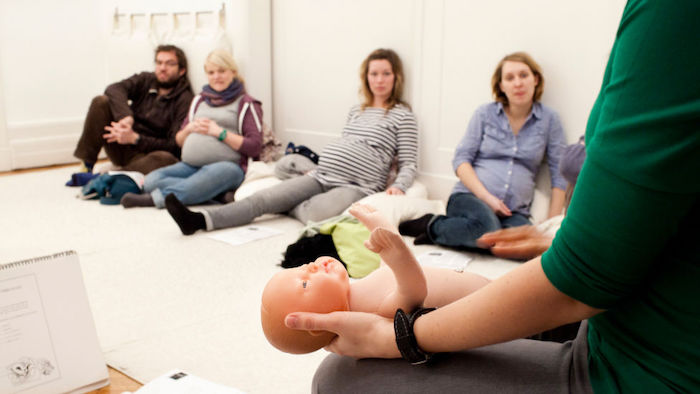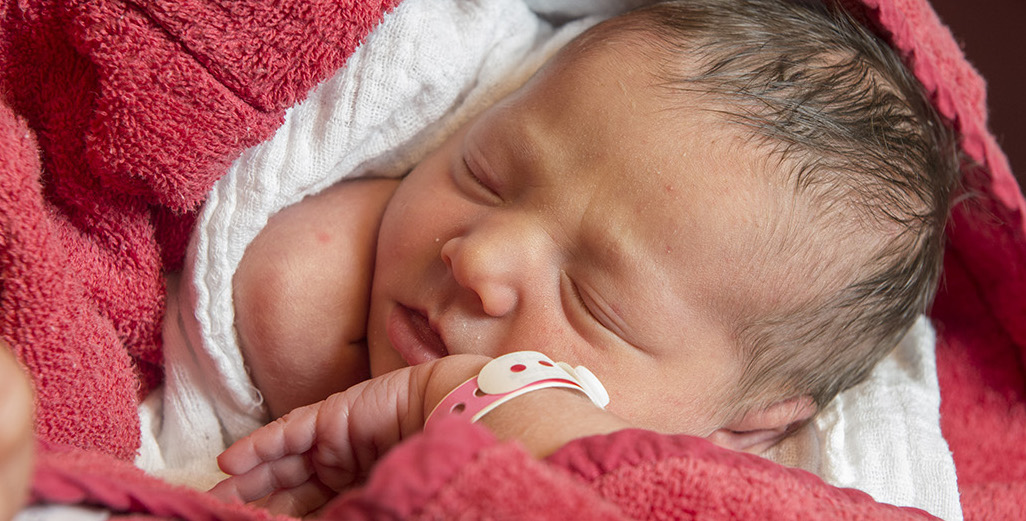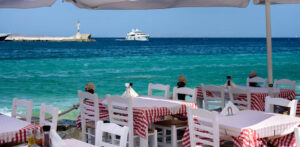(Editor’s note: This is the second in a two-part series documenting pregnancy in Austria. You can jump to Pt. 1 here.)
Childbirth is a big deal. So big, in fact, that our post for pregnancy and giving in birth needed more space than a single article could accommodate. In the first part of “Pregnancy in Austria,” (link), I focused on the planning and organization that my partner and I undertook in the first two trimesters before our son was born.
Including how to decipher the Mutterkindpass, finding your midwife, plan for screenings and scans and what to expect when planning your hospital birth, the first part of this post can hopefully help reduce the stress and anxiety of giving birth in a country (and in a language) that is not your own.
Please remember that if any of the information is not clear in the first article, simply googling “Birth in Austria” can help guide you in the right direction so that you can feel calm and supported during this momentous and exciting change in a foreign land.

Birth Preparation Course ( Geburtsvorbereitungskurs)
Once the hospital and midwife have been found and reserved, and your final ultrasounds and tests have taken place, it is nearly time for the main event! In order to prepare for this, I really recommend signing up for a Birth Preparation Course (Geburtsvorbereitungskurs) so that you have an idea what to expect, especially if it’s your first child.
Even if you have already had a child, it is a great resource and reminder for what is coming, especially if your earlier births were in another country. Around the middle-to-end of the second trimester, it is possible to sign up for a course at a hospital of your choice at a convenient time, although of course the earlier you sign up the more options you will have.
However, there are many many possibilities, so it’s easy to find one that fits your needs and schedules. We took part in a course at the Sankt-Josef Hospital where we were registered to give birth, which I really appreciated and meant a lot to me for a few reasons.
As a first-time father in a new country, I was quite nervous about the where/how/when once we arrived at the hospital.
Part of our Birth Preparation Course was a tour of the birthing rooms where we would check in when we arrive, the best places to park in the neighbourhood and even such simple things that I hadn’t considered, such as where in the Birthing Ward we could find coffee, tea or snacks. I was extremely impressed with Sankt-Josef Hospital, partly for their concise and clear explanations and also for the small touche … such as a constant supply of drinks and fresh bread or fruit, a simple contribution that made all the difference on the big day.
The other information that we received at the Birth Preparation Course was extremely broad and incredibly helpful. From how to navigate the hospital, whether to drive yourself or call an ambulance and what to expect when you arrive. There was also detailed discussion of what to expect during the birth itself and how contractions progress and the stages of birth itself. There was also hands-on practice for how to help your partner with pre-birth exercises, and how to hold and support your partner during the actual birth.
Toward the end of the day, the men were separated so that the women could focus on breast-feeding information, and taken to another room.
As I have only experienced birth in Austria I cannot compare, but I was very impressed with what happened in the Men’s Only session. In a great contrast to previous generations, the men were encouraged to share their fears and concerns about birth, reflect on their relationship with their own fathers and explore the new role that was about to be bestowed upon them.
Although many men did not get too “touchy-feely,” it was a fantastic evolution in partnership and anti-machismo to allow the opportunity for men to share their concerns with other men, which I really appreciated.
Maternity, paternity and parental leave

After the preparation course, it is mostly time to start nesting, reading those last minute books (as the one supporting my partner, I cannot recommend “The Birth Partner” by Penny Simkin highly enough) and checking in about Maternity Leave (Mutterschutz) and Parental Leave (Elternkarenz).
Maternity leaves starts eight weeks before the birth in Austria, and continues for eight weeks afterwards. Unfortunately, this is only for people who are not self-employed. If you are self-employed, there are other options for financial support, but they are not guaranteed.
Fathers are guaranteed a month off for Paternity Leave during the first two months, which is separate from time taken off afterwards.
Financial Aid for Children (Kinderbetreungsgeld) is applied for after the birth, and very much depends on your financial situation, you and your partners employment plan, and how long both of you plan on taking time off. It can get quite confusing, but these helpful government websites can help clear things up a little.
Essentially, you can choose two different plans which will impact how much financial assistance you get a month, and for how long. One plan is a percentage of your income for a year or less (mostly chosen by people with higher income who can support themselves with childcare to return to work sooner).
The other option is to receive a predetermined amount money from the national health insurance program (depending on your circumstances), which is divided into the number of months you and your partner wish to stay at home.
In short, the longer you take the financial aid, the less you receive each month.
Something that I especially respect in Austria is that there is a 1,000 euro bonus for mothers and fathers to take roughly equal time at home, to encourage fathers to also take the time of with their child.
The Big Day
So, you’ve got this far. And then you wake up one night at 2 a.m., your partner softly telling you that her contractions have started, and it’s time to start counting frequency and duration. When we felt it was time, we drove ourselves to the hospital, and the journey began.
As this post is about birth in Austria, I will avoid specifics and reflect on our actual experience in Vienna.
Do not worry about language if you are an English-speaker. As my partner is Austrian, the whole experience was in German, but nearly every doctor, nurse and midwife can speak English (although they might not love it!) so that you can feel confident that you will not miss any important information if your German is not up to scratch.
As we chose a midwife who would visit us after the birth and would not join us at the hospital, the midwife on duty accompanied us through every step and was calm, respectful and sweet the entire time. Her colleagues were lovely, and supported both I and my partner in any way we asked, and always arrived in our room no more than 30 seconds after we pressed the bell.
Our Birthing Room was incredible for a public hospital, and friends from abroad could not believe the quality, space and comfort that we received from a national health system.
Of course, all birthing rooms are not created equal in Austria, but we were lucky. With many hospitals, it is a bit of a gamble where exactly you will end up once contractions begin and you make your way to the hospital … unless you are going private, it depends which rooms are free when you arrive on the day. This could mean a brand new room fitted with a bath tub, couch and resting area, or a simpler version.
All rooms are private, but going public contains a certain risk about exactly which room you will end up in. But of course, this is the risk you take for a free health service!
A big decision coming – stay or leave?
After a lot of work on my partner’s part, a lot of anxiety and stress on mine, and support from a wonderful staff, our beautiful baby son was born! He was immediately laid on my partner’s chest, where he rested for a while before I was allowed to cut the umbilical cord (what an experience!). Then cleaned, weighed and swaddled, and our son joined us so that we could all rest.
After about three hours, the doctor responsible for checking the health of the newborn came to check on us. At this point, you have a decision to make. In public hospitals, you can chose to stay overnight or to leave the same day, depending on how comfortable you feel (and as long as you can prove that you have a private midwife coming to visit you at home for the next week).
Of course, if there have been complications or a Cesarean section, you will be required to stay longer (usually at least five days). After a normal birth it is up to you if you leave that night, but there is a catch. Public hospitals do not have space for the father to stay overnight also, so the mother must feel comfortable spending the first night with the baby alone in the hospital, although naturally supported by all the staff there.
As our baby was healthy, and my partner wanted to be at home with me, we left. Then followed the most white-knuckle, nerve-wracking drive of my life, but we made it!
A new life had begun.
The next few days
As stated in the first part of this article, if you do not have a private mid-wife you are required to stay in hospital for a few days for check-ups. If you have elected to have your own midwife come to your home, then they will come and visit every day for the first five days to weigh and monitor the baby. They will also bring Vitamin K for the baby, check the post-birth condition of the mother and take blood from the child which will be sent to a lab to analyse for a healthy metabolism. On top of this, it is an opportunity to ask any questions, get advice on breastfeeding and generally have a professional around to put your mind at rest.
So, we did it!
I hope that these posts were helpful and served as a general guide through our experience in Austria, and could bring some peace of mind and support during one of the most exciting,scary and beautiful times of living in a foreign country.
––––––––––
Read more about Austria here in Dispatches’ archives
See more from Thom here.
Thom Harding was born and raised in the UK and USA, sharing his time between Bath and Boston. Upon completing his studies in Art History and Painting in Florence, Thom travelled around Mexico and India before moving to New Mexico to start his career as a Primary school teacher.
After completing his MA in Education, he now lives and works in Vienna, Austria and enjoys spending his free time hiking, reading, travelling and exploring around Europe.
See more of Thom’s work here in the Dispatches archive.
You can read more about Vienna here in the Dispatches archives.















